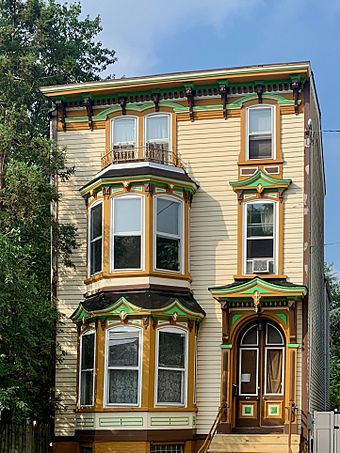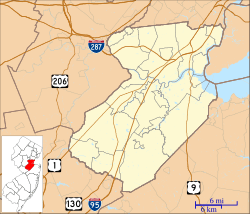William H. Johnson House facts for kids
|
William H. Johnson House
|
|

William H. Johnson House in 2020
|
|
| Location | 52 Welton Street, New Brunswick, New Jersey |
|---|---|
| Area | less than one acre |
| Built | 1872 |
| Architectural style | Italianate |
| NRHP reference No. | 06000560 |
Quick facts for kids Significant dates |
|
| Added to NRHP | July 12, 2006 |
The William H. Johnson House is a special old house in New Brunswick, Middlesex County, New Jersey, United States. It was built around 1872. This house is important because it shows us what homes looked like a long time ago. It also tells us about the people who lived there.
Contents
Who Was William H. Johnson?
This house is named after its first owner, William H. Johnson. He was born in 1829. Mr. Johnson lived in this house until he passed away on February 26, 1904.
William H. Johnson was a successful businessman in New Brunswick. He owned a company that hung wallpaper and painted houses. His business had offices on Church Street and Morris Street in New Brunswick. He lived in this house with his wife, Sarah, and their daughter, Adilade.
What Makes the House Special?
The William H. Johnson House is a great example of Victorian design. It was built in the Italianate style. This style was popular right after the Civil War. At that time, New Brunswick was growing fast.
Italianate Style Features
The house has many features that show the Italianate style. These include tall, narrow windows with arched tops. It also has double bays, which are parts of the house that stick out. Look for the decorative brackets under the roof, called cornice brackets. The roof itself is low and gently sloped.
Original Details Inside
The house is important because many of its original decorations are still there. This includes some wallpaper from the late 1800s. People believe William H. Johnson himself might have hung this wallpaper. This helps us see how homes were decorated long ago.
Why is it a Historic Place?
The William H. Johnson House was added to the National Register of Historic Places on July 12, 2006. It was recognized for its special architecture. Being on this list means it is an important historical building.
Helping the William H. Johnson House
A group called "Friends of The William H. Johnson House" was created to help this historic building. This group works to support the house in many ways.
Their main goals are to restore, preserve, and maintain the house. They also want to teach people about the building and the people who lived there. Through education and outreach, they help the community learn more about its local history.




